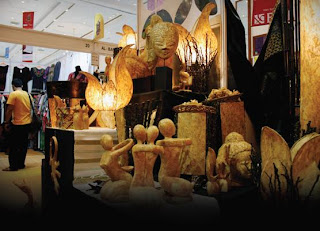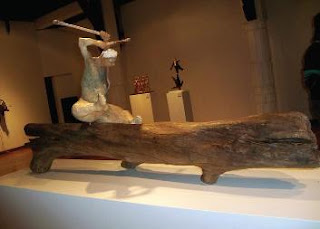It is time for mankind to make time to listen and understand nature’s ailment.
After disappearing for so long from the world of sculpture art, Bambang Adi Pramono came back, displaying his latest sculpture masterworks.
This sculpture artist was born in Sidoarjo, East Java, July 7 1955. He graduated from ISI Jogjakarta in 1976. In 1981 he held a sole exhibition in ISI Jogjakarta that was then still located in Gampingan. This second sole exhibition is a process of his artistic rebirth by bringing more fulfilling masterpieces.
Bambang’s sculpture works are mostly based from wood and metal, ranging is sizes from 50 to 350 cm. For him, the media wood and metal are two natural elements with different characters, be it from the texture or processing technique aspects.
Both of the elements are combines into beautiful and unique work of art. His works talk of the contemplation of life, nature’s anguish, ecological damage, the set-aside animal kingdom, to the wonders of mythological creatures such as dragons.
In the series of sculptures with dragon theme, Bambang made an effort in upholding the philosophical values of the dragon legend. With his brilliance in formulating aesthetics, the dragons that appear in Bambang’s works are not a whole dragon, but displayed through certain elements of the dragon’s body. The said is shown, for example, on his works titled “Dragon’s Mouth”, “Dragon’s Hearth”, “Dragon’s Penishhh”, “Dragon Egg”. Bambang says that the dragon is a symbol of masculinity as well as beauty.
 Some of his works also talk of the rage of nature. For instance, the work titled “The Wave: 5th Anniversary of Tsunami” tells a story of the tsunami disaster in Aceh that is so haunting. This wooden based sculpture takes on the shape of a gaping wave with terrifying sharp fangs.
Some of his works also talk of the rage of nature. For instance, the work titled “The Wave: 5th Anniversary of Tsunami” tells a story of the tsunami disaster in Aceh that is so haunting. This wooden based sculpture takes on the shape of a gaping wave with terrifying sharp fangs.
In the work “Living Tree”, Bambang tells the story of a log of tree that survived in a draughty land, for the sake of sustaining life. This work also consist the critics on how mankind is getting more ignorant towards life of the trees. The wor “Kekayon II, Rhythm in Chaos” is a reflection on how nature in its hierarchy contains the beat of its own chaos, waiting for the time to explode. With that, it is time for mankind to take some time to listen and comprehend the ailment of nature.
After disappearing for so long from the world of sculpture art, Bambang Adi Pramono came back, displaying his latest sculpture masterworks.
This sculpture artist was born in Sidoarjo, East Java, July 7 1955. He graduated from ISI Jogjakarta in 1976. In 1981 he held a sole exhibition in ISI Jogjakarta that was then still located in Gampingan. This second sole exhibition is a process of his artistic rebirth by bringing more fulfilling masterpieces.
Bambang’s sculpture works are mostly based from wood and metal, ranging is sizes from 50 to 350 cm. For him, the media wood and metal are two natural elements with different characters, be it from the texture or processing technique aspects.
Both of the elements are combines into beautiful and unique work of art. His works talk of the contemplation of life, nature’s anguish, ecological damage, the set-aside animal kingdom, to the wonders of mythological creatures such as dragons.
In the series of sculptures with dragon theme, Bambang made an effort in upholding the philosophical values of the dragon legend. With his brilliance in formulating aesthetics, the dragons that appear in Bambang’s works are not a whole dragon, but displayed through certain elements of the dragon’s body. The said is shown, for example, on his works titled “Dragon’s Mouth”, “Dragon’s Hearth”, “Dragon’s Penishhh”, “Dragon Egg”. Bambang says that the dragon is a symbol of masculinity as well as beauty.
 Some of his works also talk of the rage of nature. For instance, the work titled “The Wave: 5th Anniversary of Tsunami” tells a story of the tsunami disaster in Aceh that is so haunting. This wooden based sculpture takes on the shape of a gaping wave with terrifying sharp fangs.
Some of his works also talk of the rage of nature. For instance, the work titled “The Wave: 5th Anniversary of Tsunami” tells a story of the tsunami disaster in Aceh that is so haunting. This wooden based sculpture takes on the shape of a gaping wave with terrifying sharp fangs.In the work “Living Tree”, Bambang tells the story of a log of tree that survived in a draughty land, for the sake of sustaining life. This work also consist the critics on how mankind is getting more ignorant towards life of the trees. The wor “Kekayon II, Rhythm in Chaos” is a reflection on how nature in its hierarchy contains the beat of its own chaos, waiting for the time to explode. With that, it is time for mankind to take some time to listen and comprehend the ailment of nature.








































